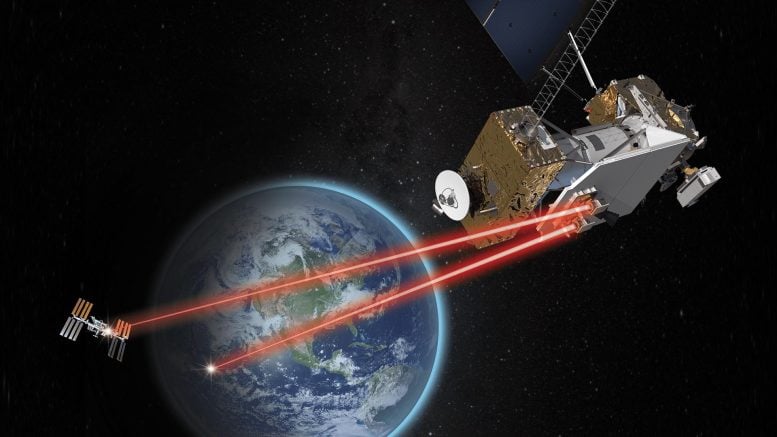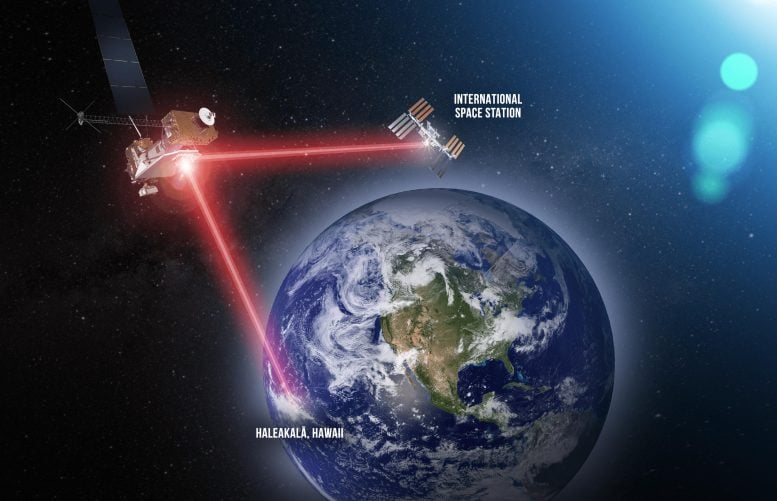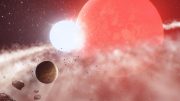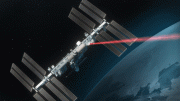
Illustration of NASA’s Laser Communications Relay Demonstration communicating with the International Space Station over laser links. Credit: NASA’s Goddard Space Flight Center
Update: The December 5 launch was scrubbed and rescheduled for December 6.
Update: The December 6 launch was scrubbed and rescheduled for December 7.
NASA is taking a step toward the next era of space communications with the launch of its Laser Communications Relay Demonstration (LCRD) on Sunday, December 5. Live coverage of the launch is scheduled to air on NASA Television, the agency’s website, and the NASA App beginning at 3:30 a.m. EST.
The agency’s first end-to-end laser relay system, LCRD is set to launch as part of the United States Space Force Space Systems Command’s Space Test Program 3 (STP-3) mission. STP-3 will launch on a United Launch Alliance (ULA) Atlas V rocket from Cape Canaveral Space Force Station in Florida. Its two-hour launch window opens at 4:04 a.m. EST.
6 Things You Need To Know About NASA’s Revolutionary Laser Communications Mission
Laser communications – also called optical communications because they use light to send information – offer higher data rates than traditional radio frequency systems, enabling more data to be transmitted with each transmission. LCRD will demonstrate space-to-ground laser communications linking ground stations in Hawaii and California. Later in mission, LCRD will receive and transmit data from an optical terminal that NASA will place on the International Space Station.
Public Participation
NASA invites the public to register to virtually attend the launch and receive mission updates and activities via email. NASA’s virtual guest program for LCRD includes curated launch resources, notifications about related opportunities, and a virtual guest passport stamp.
Dive Deep into Laser Communications
Take an inside look into the development of LCRD with a laser communications show from NASA EDGE.
NASA’s The Invisible Network podcast will debut a special LCRD series on launch day, with additional episodes released over the following four Wednesdays. The podcast will highlight the future of the laser communications technologies demonstrated by this mission and the people behind it.
NASA’s LCRD is launching aboard the Department of Defense’s Space Test Program Satellite-6 (STPSat-6), which is part of the Space Test Program 3 mission. An additional NASA science payload also will launch aboard STPSat-6: UVSC Pathfinder, the Ultraviolet Spectro-Coronagraph Pathfinder. The mission is a joint NASA-U.S. Naval Research Laboratory experiment that studies the origins of solar energetic particles, the Sun’s most dangerous form of radiation.
LCRD is led by NASA’s Goddard Space Flight Center in Greenbelt, Maryland. Partners include NASA’s Jet Propulsion Laboratory in Southern California and the MIT Lincoln Laboratory. LCRD is funded through NASA’s Technology Demonstration Missions program as part of the Space Technology Mission Directorate, and the Space Communications and Navigation (SCaN) program at NASA Headquarters in Washington.










Be the first to comment on "NASA Laser Communications Demonstration – Here’s How To Watch the Launch Live"